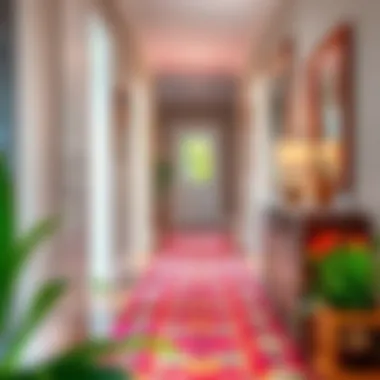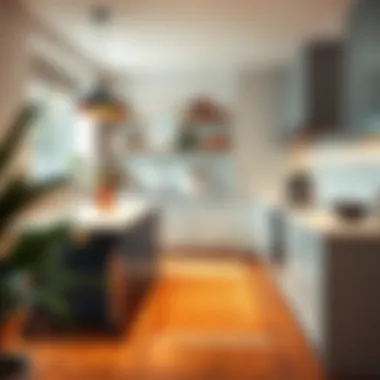The Impact of Small Runners on Interior Design


Intro
In the world of interior design, the subtleties often speak volumes. Among the many elements that contribute to a well-thought-out space, small runners stand out. These simple yet profound additions to a home can transform areas from mundane to luxurious. It's not just about aesthetics; it's about functionality, cohesion, and even emotional warmth that they can bring to different rooms. With their versatility in design, they find homes in modern settings, vintage abodes, and everything between. This article will shed light on how small runners play an integral role in enhancing the visual appeal and functionality of spaces.
Design Inspiration
Diving into the world of small runners necessitates an appreciation for the style statements being made. They are not merely pieces of fabric; instead, they are canvases where patterns, colors, and textures meld to define a space. Small runners can shape not only the look of a room but also its mood.
Trending Design Styles
Today’s design landscape is rich with varied influences, and small runners are adapted to fit an array of styles. Here are a few prominent trends:
- Minimalism - In minimalist designs, small runners often feature neutral shades and straightforward patterns. Their purpose is to amplify clean lines and an uncluttered feel.
- Bohemian - On the flip side, the Bohemian style welcomes eclectic patterns, vibrant colors, and rich textures. Here, small runners make bold statements, inviting warmth and a sense of personality into spaces.
- Scandinavian - Characterized by functionality and simplicity, Scandinavian designs often employ runners that embody both warmth and style, utilizing natural fibers and muted colors to create serene environments.
Color Palettes and Themes
When incorporating small runners, the color scheme of a room holds significant weight.
- Monochromatic Schemes - Using a runner in a monochromatic color scheme can unify a room, drawing the eye down a hallway or accentuating a living area.
- Contrasting Colors - Conversely, runners can serve as focal points through contrasting colors. For instance, a bright runner on a muted floor can create a striking visual impact.
Selecting a small runner that resonates with the overall theme of a room requires a delicate balance of color, texture, and pattern.
"Small details can make a significant difference in interior design. Runners bring focus, warmth, and structure to spaces."
Practical Tips
Even with the right inspiration, the application of small runners requires keen insight into practical implementation. Let's explore actionable techniques to optimize the space with small runners.
Space Optimization Techniques
Small runners can enhance space perception and flow. Here are some suggestions for their effective use:
- Place runners in hallways to elongate the visual dimensions of a space.
- Utilize them in narrow areas, such as beside beds or through kitchen walking paths, to create defined pathways that guide movement seamlessly.
- Experiment with different sizes. A longer runner can add depth, whereas a shorter one can draw attention to specific areas.
DIY Furniture Projects
For those who like to roll up their sleeves and get crafty, small runners can be integrated into DIY furniture projects:
- Table Runners: Turn a beautiful small runner into a stunning tabletop display over side tables or dining tables.
- Cushion Covers: Use remnants from runners to create unique cushions that tie in the runner's pattern and color with other elements of the room.
- Art Pieces: Frame sections of a vibrant runner as modern wall art, creating a unique and personalized touch to your décor.
In summary, small runners bridge practicality and artistry in interior design. Thoughtfully selected and placed, they can unify spaces, enhance functionality, and add essential character. This article will continue delving deeper into the materials, applications, and maintenance to optimize their use in living spaces.
Understanding Small Runners
In the realm of interior design, the role of small runners can often be overlooked, yet their importance looms large when it comes to elevating spaces. Small runners are not just decorative accents but serve numerous functions that transform how we experience our surroundings. These slender pieces can unify design elements, demarcate areas, and even add a dash of personality to a room without overwhelming it. Understanding the significance of small runners in various settings can provide homeowners, designers, and enthusiasts with unique insights into optimizing their interiors.
Definition and Purpose
Small runners, in essence, are narrow rugs or textile pieces typically placed in hallways, entryways, or other narrow areas of a home. Their purpose extends beyond aesthetics; they are functional items that contribute significantly to the ambiance of a space. For instance, in an entryway, a runner serves to guide guests while providing warmth and comfort underfoot. In kitchens or dining areas, it can delineate a dining space from other functional zones, making the area feel cohesive and intentional.
The dimensions of small runners can vary, yet they generally range from 2 to 4 feet in width and are around 5 to 10 feet long, tailored to fit snugly in designated spaces. This versatility allows for a myriad of design possibilities. From a practical standpoint, runners can also protect flooring from wear and tear, particularly in high-traffic areas.
Moreover, selecting a runner with the right design, color, and material can enhance the overall aesthetic of an interior, making it feel pulled-together. They can act as a pop of color in a neutral space, introducing texture or pattern that invigorates the room.
Historical Context
The historical background of small runners reveals much about their evolution and sustained relevance in interior spaces. This design element can be traced back to numerous cultures that recognized the need for both functionality and decor. In ancient Middle Eastern cultures, intricate textiles were employed for not just their beauty, but also for practical purposes such as insulation and comfort. These early runners were often woven by skilled artisans, resulting in rich patterns and colors that conveyed both cultural significance and craftsmanship.
Over time, small runners became popular in Western interiors, especially during the Victorian era, where opulent designs were hallmarks of the period. Homes featured long hallways, thus necessitating the use of runners to not only add beauty but to also serve a practical purpose in protecting wooden floors. Today, the design landscape has evolved greatly; small runners are produced in various materials – from luxurious wool to economical synthetics, reflecting current trends and consumer demands.
In contemporary design, these objects have come to embody a mixture of history and modern functionality. Homeowners are likely to choose runners that resonate with their personal style while also being mindful of the practicalities that these textiles offer.
"Understanding the historical context of small runners adds depth to their role in modern design, connecting past practices with current trends."
In summary, small runners are more than mere decorative pieces; they emerge from a rich tapestry of history and practicality. Recognizing their definition, purpose, and historical evolution allows one to appreciate their multifaceted role in enhancing both function and style within home environments.


Design Principles for Small Runners
Understanding the design principles that govern the use of small runners can significantly enhance both their aesthetic and functional impact in interior spaces. This section is dedicated to unraveling the core elements that make small runners not just a decorative piece, but a pivotal aspect of interior design. By effectively considering scale, color theory, patterns, and textures, homeowners and designers can create spaces that are visually appealing and practical. These principles help to harmonize various design elements, ensuring that small runners complement rather than clash with the surroundings.
Scale and Proportion
When it comes to incorporating small runners into a space, the concepts of scale and proportion must be at the forefront of your design strategy. Scale refers to the size of the runner in relation to the area it's placed in, while proportion deals with the relationship between different design elements. A small runner that is well-scaled can visually elongate a narrow hallway or enhance the dimensions of a smaller room.
- Surroundings Matter: Consider the size of furniture and other decor elements. A petite runner fits snugly under a coffee table or entryway bench, creating a balanced appearance that feels natural. On the other side of the coin, if the runner is oversized for the space, it can overwhelm the eye, making the room feel cluttered.
- Visual Flow: Maintaining a consistent flow is crucial. A small runner laid in a straight line from the entryway to the living space can guide the eye and foot traffic smoothly, providing an organized look. Use the dimensions of the runnner to enhance the perception of depth or breadth in a space.
"For small runners, scale and proportion aren't just preferences; they're principles that dictate harmony and flow in design."
Color Theory in Textiles
Color has a profound impact on the mood and energy of a space. When selecting a small runner, understanding color theory is key. Different colors can evoke varied emotions and create different atmospheres.
- Warm and Cool Tones: Warm colors such as reds and oranges tend to create a cozy, inviting feel, while cool colors like blues and greens can promote calmness. Choosing the right temperature for your runner influences the overall tone of the room.
- Complementary Choices: Consider using a small runner as an accent piece. If your room features neutral tones, a vibrant runner can serve as a striking focal point. Conversely, picking a runner with subdued shades can help unify other bold elements in the room.
- Mood Setting: Different colors can influence mood. A light, pastel-colored runner can make a small kitchen feel airy, while deeper shades can add sophistication in a dining area.
Patterns and Textures
The use of patterns and textures in small runners is integral to enriching a space. They add depth and interest that elevates the overall design.
- Types of Patterns: Geometric patterns can create an illusion of space, while floral or organic patterns add warmth and comfort. For example, a plaid runner may echo rustic decor, while stripes can modernize an otherwise classic aesthetic.
- Texture Play: Textures can engage the senses. A woven runner might add a tactile experience that makes a space feel cozier. Consider mixing textures—like pairing a plush runner with sleek furniture—to create contrast and dynamicity.
- Cohesion and Contrast: A small runner should flow well with other textiles, such as throw pillows or blankets. Mixing patterns can work if they share color palettes, making the room feel cohesive yet interesting.
By understanding and applying these design principles for small runners, you can create spaces that are not only functional but also rich in character and style. Opting for the right scales, colors, and textures can significantly enhance the visual narrative of any room.
Material Considerations
When considering the role of small runners in interior design, material choice is a vital aspect that needs thorough examination. The materials used in these textiles not only influence aesthetic appeal but also affect durability, maintenance, and ethical sourcing practices. Choosing the right material can enhance functionality within various spaces while aligning with personal values related to sustainability and environmental concerns. Understanding the different material types helps homeowners and designers make informed choices that ultimately shape the character of a room.
Natural Fibers vs. Synthetics
In the debate between natural fibers and synthetic materials, both options carry their own strengths and weaknesses. Natural fibers, such as wool, cotton, and jute, are often favored for their tactile qualities and ecological benefits. Wool, for instance, boasts inherent stain-resisting properties and remarkable durability, making it an ideal choice for high-traffic areas. Cotton, known for its softness, is pleasant underfoot but may require more regular care to maintain its appearance.
On the flip side, synthetic fibers like nylon and polypropylene have earned their reputation for resilience and affordability. They can mimic the look of natural fibers while providing added wear resistance. However, one might ponder the long-term implications of choosing synthetics—these materials are derived from petroleum-based products, posing questions about environmental impacts.
"The choice between natural and synthetic fibers is often a balancing act between aesthetic preferences and functional requirements."
When selecting a runner, consider the intended space and the lifestyle of the inhabitants. For instance, a family with children may benefit more from durable synthetic options that can withstand spills, while a serene bedroom setting may call for the warmth of natural wood.
Durability and Maintenance
Durability is an essential component of any small runner's material consideration. The fabric must endure not only foot traffic but also the wear and tear that comes with everyday life. Wool and nylon, for example, stand out for their resilience, while delicate fabrics like silk are better reserved for spaces with minimal traffic. Regular maintenance also plays a crucial role in prolonging the life of a runner.
For natural fiber runners, regular vacuuming, spot cleaning, and occasional professional cleaning will do wonders. Synthetic runners may require deeper cleaning with a mild detergent and water to avoid deterioration. Understanding the maintenance requirements of your chosen material is fundamental. Failure to adhere to proper cleaning protocol can lead to premature damage, affecting both appearance and longevity.
Environmental Impacts of Material Choices
As sustainability gains traction in the design world, the environmental impacts of material choices cannot be overlooked. The production processes for both natural and synthetic fibers yield varying consequences for our planet. Natural fibers derived from sustainable farming practices present a low-carbon footprint, but they may also involve the use of chemicals during processing.
Conversely, synthetic fibers often contribute to plastic pollution and can take hundreds of years to decompose. Eco-friendly alternatives, like recycled polyester or biodegradable fibers, have become increasingly available, merging function with environmental consciousness. As consumers and designers prioritize green choices, it's paramount to evaluate where materials come from and how they are produced.
In sum, when it comes to small runners, material considerations extend far beyond mere aesthetics. They encompass durability, maintenance, and environmental implications, all of which play a crucial role in creating a harmonious and responsible living environment. By being discerning in material selection, homeowners can elevate the practicality and beauty of their spaces while aligning with broader sustainability goals.
Functional Aspects of Small Runners
The role of small runners in interior design extends far beyond mere decoration. These versatile textiles serve functional purposes that directly influence both the ambiance and practicality of spaces. Just like a well-placed piece of art, a thoughtfully chosen runner can tie a room together, making it feel more cohesive and inviting. Understanding these functional aspects helps homeowners and designers leverage their full potential.
Defining Space within Open Concepts
In modern design, open-concept layouts are becoming increasingly popular, particularly in homes that strive to maximize space and light. Small runners play a crucial part in defining these expansive areas, acting as visual cues that guide a person's movement through the room.
For example, placing a runner between a living area and dining area can signal a transition, establishing distinct zones without erecting walls. This subtle delineation helps maintain an airy feel while ensuring that each space serves its unique purpose. Choosing a runner that contrasts with the flooring can heighten this effect, drawing the eye and encouraging navigation through the space.
Here are some tips for using runners to define areas in open layouts:


- Color Contrast: Select a runner that differs in color from the adjoining space to highlight transitions clearly.
- Texture Play: Use materials with varied textures, such as a soft wool runner in the living area contrasted by a durable synthetic in dining spaces.
- Directional Patterns: Opt for runners with patterns that lead the eye in the direction of the desired traffic flow.
By strategically placing small runners, homeowners can foster a sense of organization and flow, transforming expansive spaces into inviting districts.
Enhancing Safety and Comfort
Beyond aesthetics and space management, small runners significantly enhance the safety and comfort of living areas. An oft-overlooked element, they can contribute to a home's overall functionality.
In high-traffic areas, runners provide cushioned surfaces that absorb impact, making them particularly useful for households with children or elderly residents. The floor cushioning also acts as a sound dampener, reducing noise from footsteps—something that can be a Godsend in busy homes. Simply put, they bring an element of comfort that hard flooring can lack.
Keeping safety in mind, consider these aspects when using runners:
- Non-Slip Backing: Ensure runners come with non-slip features to prevent accidents, especially on tile or hardwood floors.
- Thickness: Choose a thickness that provides comfort but is not so high that it creates a tripping hazard.
- Easy Maintenance: A practical runner can be easily cleaned and maintained, contributing to a safer indoor environment.
With their ability to soften hard surfaces and reduce slips, small runners are not just decorative but are essential for creating safe, comfortable spaces.
In the realm of interior design, sometimes it’s the smaller elements that can have the biggest impact.
In summary, the functional aspects of small runners in interior design should never be underestimated. They effectively define spaces in open layouts while enhancing comfort and safety. By understanding their multifaceted roles, homeowners and designers are better equipped to harness their potential, creating environments that are not only beautiful but also practical.
Placement Strategies for Small Runners
Placing small runners in your interior isn’t just about throwing a piece of fabric on the floor. It involves thought, strategy, and finesse. These dynamic pieces serve both aesthetic and functional roles, shaping the character of various spaces within the home. When you consider placement carefully, you can significantly enhance the flow, warmth, and overall vibe of a room.
Ideal Locations in the Home
Identifying the best spots for small runners is akin to picking the right frame for a masterpiece. Here are some prime locations:
- Entryways: A runner at the entryway can welcome guests while catching dirt and moisture. Its placement here not only serves a purpose, but also sets the initial tone of your home.
- Kitchens: Consider placing runners in front of sinks or cooking areas. It’s practical for standing long periods, providing comfort and delight underfoot while making a style statement.
- Hallways: A runner in a hallway can create a sense of movement, guiding visitors through the space while adding warmth to otherwise stark passages.
- Living Rooms: In this frequently used area, a runner can define relaxation zones, complementing the main seating arrangement.
Choosing these locations allows for visual continuity and can also help define areas in open-concept layouts, allowing a more streamlined flow of movement.
Layering with Other Textiles
Layering is where you can really let your creativity soar. In effect, layering small runners with other textiles deepens textures and adds dimension to a room. Here’s how to weave this strategy into your design:
- Rugs Over Rugs: Placing a small runner on top of a larger area rug creates an engaging contrast. This approach highlights both pieces while serving the dual purpose of cushioning.
- Textile Coordination: Pairing runners with other fabric elements, like cushions or throws, in matching or complementary colors can tie a room together beautifully. Think about how patterns intermingle and the messages they convey; subtle or bold, there’s room for both.
- Layering in Different Heights: Think vertically as well when layering textiles. A runner can sit above a low-profile area rug, mingling different textures and heights to invite tactile engagement.
Utilizing layered fabrics encourages a layered aesthetic, bestowing a sense of coziness and promoting warmth. Additionally, it offers an opportunity to play with color, pattern, and texture, making spaces feel dynamically rich.
"The way you place your runner is like a silent conversation in your home that reflects your style, your character."
In all, being intentional with where and how small runners are placed creates a cohesive narrative throughout your space. Considering their function and style impact elevates them from mere accents to vital elements of your interior design.
Styling Small Runners in Various Environments
Styling small runners in different environments plays a crucial role in enhancing the visual appeal and functionality of any interior space. These versatile textiles can pack a punch in terms of both comfort and design, often serving as the unsung heroes of home decor. Understanding how to effectively utilize them in various areas not only broadens their stylistic possibilities, but also allows homeowners and designers to create inviting atmospheres that resonate with personal taste and lifestyle.
In the Living Room
The living room, often viewed as the heart of the home, is where families gather and entertain guests. Here, small runners can serve multiple purposes. They can add warmth to hardwood floors or act as a boundary to define a seating area. For instance, using a runner that complements the color palette of your furniture can pull together the entire room.
When choosing a runner for this space, consider:
- Color Harmony: A soft hue can create a serene atmosphere, while bold colors can add a splash of energy.
- Texture: Opting for a textured fabric can enhance the tactile experience of the room.
- Pattern: Geometric or abstract patterns can offer a modern edge, while floral designs can evoke more traditional aesthetics.
The placement should mimic traffic flow, ensuring it lies flat and does not create trip hazards, especially in households with children or elderly individuals.
In Entryways and Hallways
Entryways and hallways are the first impressions of a home. Small runners in these spaces not only welcome visitors but also add depth and personality. When selecting runners for entryways or hallways, focus on functionality, since these areas often experience high foot traffic.
Factors to consider include:
- Durability: Choose materials that can withstand wear and tear, such as polypropylene or tightly woven wool.
- Color: Darker colors can hide dirt better, while light colors can brighten up the often narrow spaces.
- Size: Ensure the runner fits the space without overwhelming it. It should complement rather than dominate the area.


By strategically placing a well-chosen runner here, you can create a seamless transition from the outdoors into your living space, setting the tone right from the start.
In Kitchens and Dining Areas
The kitchen and dining areas are social hubs where style meets practicality. Small runners can add a touch of flair while also serving to protect floors from spills and stains. In these areas, consider using machine-washable fabrics for easy cleaning.
For instance:
- Color Coordination: Align the runner with your kitchen color scheme by either matching or creating contrast with your cabinetry or dining table.
- Pattern Options: Floral or plaid patterns can add charm, while solid colors can lend a more contemporary feel.
- Placement: Position runners in front of sinks or under the dining table to catch spills and crumbs efficiently.
"Adding a small runner in the kitchen can elevate its design without making it feel overhorned."
In Bathrooms
When it comes to styling bathrooms, small runners can significantly elevate an otherwise utilitarian space. They can introduce luxury and comfort underfoot, especially on cold tiles. Here are some tips for selecting bathroom runners:
- Material: Look for water-resistant and quick-drying materials, such as microfiber or cotton blends, to counter moisture.
- Colors and Patterns: Soft shades and subtle patterns can create a relaxing ambiance, while vibrant options can energize the space.
- Size and Shape: Match the runner’s dimensions with the vanity area or tub to ensure it fits well without obstructing movement.
Maintenance and Care for Small Runners
Proper maintenance and care of small runners is crucial in preserving their aesthetic and functional characteristics. Small runners can anchor space, but if they’re not cared for, they can quickly become ragged and unattractive. Regular upkeep not only extends their lifespan, making them a worthwhile investment, but it also ensures that they continue to contribute positively to the interior environment.
Cleaning Techniques Based on Material
The cleaning method for small runners largely depends on the material they are made from. Here are some common materials and respective cleaning techniques:
- Wool: This is a popular material for runners due to its durability and natural stain resistance. For routine cleaning, a soft brush to remove dirt works well. For stains, a mild detergent mixed with water can be applied gently. Avoid soaking the runner, as wool can shrink.
- Synthetic Fibers: Common in budget-friendly runners, these tend to be stain-resistant and easy to clean. Vacuuming regularly is essential. Stains can often be treated with a damp cloth and a bit of soap or a dedicated carpet cleaner.
- Natural Fibers like Jute or Sisal: These materials provide a rustic charm but can be tricky. Regular vacuuming is necessary to keep dirt at bay. For stains, try a dry cleaning sponge or a mild brush with water.
When tackling stubborn stains, always perform a spot test on a small, inconspicuous area, ensuring that there is no adverse reaction.
Preventing Wear and Tear
When it comes to ensuring the longevity of your small runners, prevention is better than cure. Here are a few strategies:
- Placement: Position your runners in low-traffic areas if possible. Avoid placing them in spots where they may get stepped on frequently or subject to heavy furniture movement.
- Rotation: Just like a good pair of shoes, rotating your runners allows for even wear. Consider moving them around your home to balance out their exposure to foot traffic.
- Padding: Adding a quality rug pad underneath your runner not only provides an extra cushioning layer but also helps to prevent slippage, which can lead to accidental damage.
- Careful Cleaning: Over-cleaning can sometimes lead to more problems than it solves. Stick to a set cleaning schedule, without excessive scrubbing, which can wear down fibers over time.
- Regular Inspections: Every so often, check for signs of damage. Addressing loose threads or frays at an early stage can save significant trouble down the line.
"A little care can go a long way in keeping your small runners looking new. It’s all about mindfulness and routine!"
By maintaining a proactive approach to cleaning and caring for your runners, you ensure they continue to enhance your living spaces for years to come. Ultimately, these small yet significant pieces can profoundly influence the overall feel of a room. Take the time to care for them, and the reward will be a stylish and inviting home.
Trends in Small Runners
As interior design continually evolves, small runners have taken on a significant role in shaping spaces. Their importance lies not only in aesthetics but also in practicality. Understanding current trends in small runners is essential for homeowners, designers, and enthusiasts. It allows them to make informed choices that not only enhance their interiors but also resonate with personal style.
Current Market Trends
Current demands in the market reflect a shift towards minimalism and functional design. These trends can generally be categorized into a few key elements:
- Bold Colors and Patterns: One thing is for certain—neutral tones are making way for vibrant colors and abstract designs. Runners are now used as statements that break away from the overly calm color schemes of the past.
- Sustainable Materials: The focus on eco-friendliness is more prominent than ever. Consumers are increasingly favoring natural fibers like jute and organic cotton over synthetic options. This not only reduces environmental impact but also adds a unique texture to spaces.
- Customization: Many retailers offer personalized runners, allowing individuals to choose dimensions, colors, and patterns that suit their specific needs. This tailored approach gives homeowners a chance to curate their spaces like never before.
- Multi-functionality: Small runners are now often designed to serve multiple purposes, such as shielding floors from daily wear, directly tying two decor pieces together, or even acting as a central harmony piece within a large, open floor plan.
"Functional items can still add flair to a home, making small runners an unmissable component in modern design."
Influence of Cultural Aesthetics
Cultural influences on small runners are increasingly significant. Each design can evoke personal connections or memories, providing a layer of emotional depth to spaces. Some noteworthy aspects include:
- Cultural Patterns and Symbols: Many designs borrow elements from traditional textiles around the world. This lends a sense of heritage and storytelling to modern interiors. Think Persian-style patterns or Moroccan tiles seamlessly integrated into contemporary settings.
- Fusion Styles: An interesting trend is the fusion of various cultural elements. For instance, the mix of Scandinavian minimalism with Japanese Wabi-Sabi aesthetics allows small runners to serve not just as decor, but as a bridge between traditions.
- Tribal Influences: Designs inspired by tribal art are increasingly popular. These runners not only visualize a culture’s heritage but also add depth and color to a room. The connection between the past and the present makes these pieces all the more special.
Epilogue
As we draw our exploration of small runners to a close, it's worth considering the role these seemingly simple pieces play in interior design. Their impact is often understated, yet they serve multiple purposes simultaneously, enriching both the style and functionality of a space. For homeowners and designers, the careful selection and placement of small runners can enhance visual appeal, create defined areas in open layouts, and even contribute to comfort underfoot.
The Lasting Appeal of Small Runners
Small runners present a captivating juxtaposition of elegance and utility. They can transform the mundane into the extraordinary without overwhelming a room's design. By integrating various textures, colors, and patterns, small runners allow for personal expression within an interior's larger theme.
- Versatility abounds. Whether in a chic apartment’s hallway or a rustic farmhouse's kitchen, small runners adapt seamlessly, working harmoniously with the existing decor.
- Style Contributions: Different styles of runners, from contemporary to vintage, can complement an array of furniture and art, balancing the visual weight in a room.
- Comfort and Safety: They offer warmth and cushioning in frequently traversed areas, reducing fatigue during prolonged standing and acting as a slip-resistant surface.
Moreover, the inherent character of small runners allows them to narrate a story unique to each home. They can serve as a focal point or blend into the background, depending on the owner’s intent. Over time, homeowners may find that their small runner evolves alongside their personal style, making it not just a purchase but an investment in the narrative they wish to portray.
"Small runners are a testament to the power of detail in design—small elements can trigger significant changes in how a space feels and functions."
Ultimately, the lasting appeal of small runners lies in their ability to enhance overall aesthetics and provide functionality. As trends shift and personal styles develop, these foundational pieces will remain a relevant choice for those looking to refine and define their living spaces.















